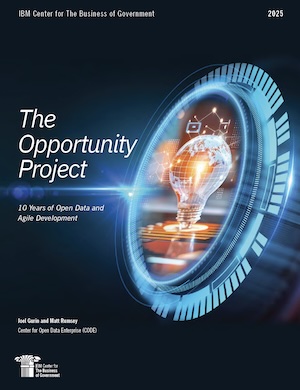
The Opportunity Project

Since its inception in 2015, TOP has continually evolved, adapting to changing circumstances and expanding its influence across various sectors. This report delves into the significant impact of TOP over the past decade, highlighting the project’s role in fostering collaboration among government agencies, civil society, and the technology industry to create innovative solutions to problems identified by agencies.
TOP traces back to a White House pilot project aimed at improving economic mobility through the application of Census and other data. Launched in 2016, TOP has since moved to the U S Department of Commerce and has become a model for developing agile approaches in government. Through 12-14 week technology development cycles (“sprints”), TOP has facilitated the creation of hundreds of digital tools that address critical issues in areas such as education, workforce development, environmental stewardship, and public health.
A key strength of TOP lies in its thematic approach to problem-solving. By organizing sprints around specific themes, such as financial and economic priorities, TOP has focused efforts on rapid prototyping of targeted solutions to pressing issues. This thematic organization ensures that strategies to address problem statements are well-aligned with the goals of key stakeholders, and fosters collaboration among participants working towards common objectives.
The impact of TOP extends beyond the development of digital tools. The program has educated a new generation of open government data users—building reciprocal relationships between government data stewards and user communities, and enhancing the accessibility and usability of large government data sets. Through a collaborative process, TOP has brought innovative strategies and agile methodologies to agencies, supporting a more flexible and user-centered government workforce.
This report also includes detailed case studies that illustrate the many ways in which TOP has made a difference, and demonstrate the tangible benefits of TOP’s approach. The case studies highlight the program’s ability to spark change and foster ongoing collaboration between government and nongovernment participants.
This report builds on a previous IBM Center report, Agile Problem Solving in Government: A Case Study of The Opportunity Project, that provides lessons for governments on how agile problem solving can enable a public-private collaboration to help address the most significant mission-focused issues. The report also complements the Center’s longstanding body of research on agile strategies for government (recent reports include Leadership Framework for Agile Government and Digital Modernization in Government: An Implementation Framework), which continues to proceed in collaboration with the National Academy of Public Administration’s Agile Government Center.
The lessons learned from TOP’s experience provide valuable insights for agencies seeking innovate approaches to address complex challenges. Through thematic sprint cycles, TOP serves as a catalyst for innovation and a model for agile problem-solving in government. This report not only records the progress of TOP, but also offers a roadmap for the continued evolution and growth of this and similar efforts in the future.



